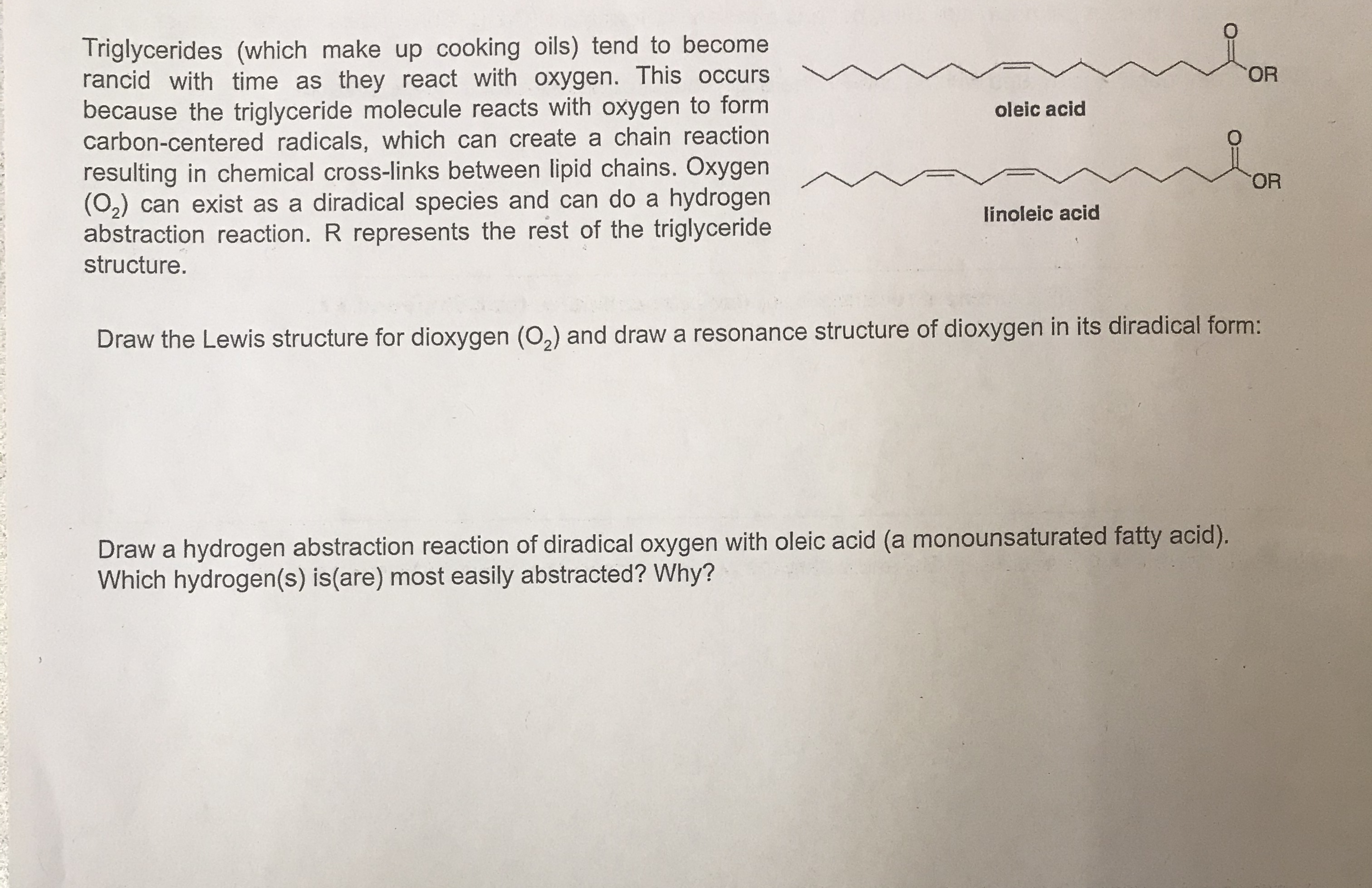
Chemistry
10th Edition
ISBN: 9781305957404
Author: Steven S. Zumdahl, Susan A. Zumdahl, Donald J. DeCoste
Publisher: Cengage Learning
expand_more
expand_more
format_list_bulleted
Concept explainers
Question
thumb_up100%
I understand that the diradical dioxygen attacks a hydrogen on the carbon adjacent to the double bond but can I be shown the resonance mechanism and why we can't use a hydrogen directly from the double bond?

Transcribed Image Text:Triglycerides (which make up cooking oils) tend to become
rancid with time as they react with oxygen. This occurs
because the triglyceride molecule reacts with oxygen to form
carbon-centered radicals, which can create a chain reaction
resulting in chemical cross-links between lipid chains. Oxygen
(02) can exist as a diradical species and can do a hydrogen
abstraction reaction. R represents the rest of the triglyceride
OR
oleic acid
OR
linoleic acid
structure.
Draw the Lewis structure for dioxygen (0,) and draw a resonance structure of dioxygen in its diradical form:
Draw a hydrogen abstraction reaction of diradical oxygen with oleic acid (a monounsaturated fatty acid).
Which hydrogen(s) is(are) most easily abstracted? Why?
Expert Solution
This question has been solved!
Explore an expertly crafted, step-by-step solution for a thorough understanding of key concepts.
This is a popular solution
Trending nowThis is a popular solution!
Step by stepSolved in 2 steps with 2 images

Knowledge Booster
Learn more about
Need a deep-dive on the concept behind this application? Look no further. Learn more about this topic, chemistry and related others by exploring similar questions and additional content below.Similar questions
- Complete the mechanism for the propagation cycle by providing the curved arrows.arrow_forwardDraw a detailed mechanism, showing appropriate bonds forming and breaking, for the reaction between cyclopentadiene and methyl acrylatearrow_forwardIs a carbon that is donating its proton a Bronsted acid and Lewis acid , does it also make it an electrophile . While it’s conjugate base will become a nucleophile ?arrow_forward
- a) Draw the ring-flip isomer of the molecule from question (b) Show which of the two is favored in the equilibrium between them, and explain why, showing all possible forms of strain in each of the isomers. (c) What is the stereochemical relationship between the two isomers? (d) Draw another stereoisomer of the molecule and show all the strains it contains.(strains is the most important one in this questuon!!!)arrow_forwardPlease correct answer and don't use hend raitingarrow_forwardDeuterium (D) is an isotope of H. Both D and H have one proton and one electron; H has no neutrons and D has one. Consequently, D and H have nearly identical behavior, but they can be distinguished from each other experimentally due to their different masses. Therefore, replacing an H with a D in a molecule-deuterium isotope labeling-can provide valuable information about a mechanism. With this in mind, how would you synthesize each of the following deuterium-labeled compounds from the analogous unlabeled compound, using D,0 as your only source of deuterium? Hint: You will have to use two separate proton transfer reactions to synthesize each one. (a) (b) (c) OD D.arrow_forward
arrow_back_ios
arrow_forward_ios
Recommended textbooks for you
 ChemistryChemistryISBN:9781305957404Author:Steven S. Zumdahl, Susan A. Zumdahl, Donald J. DeCostePublisher:Cengage Learning
ChemistryChemistryISBN:9781305957404Author:Steven S. Zumdahl, Susan A. Zumdahl, Donald J. DeCostePublisher:Cengage Learning ChemistryChemistryISBN:9781259911156Author:Raymond Chang Dr., Jason Overby ProfessorPublisher:McGraw-Hill Education
ChemistryChemistryISBN:9781259911156Author:Raymond Chang Dr., Jason Overby ProfessorPublisher:McGraw-Hill Education Principles of Instrumental AnalysisChemistryISBN:9781305577213Author:Douglas A. Skoog, F. James Holler, Stanley R. CrouchPublisher:Cengage Learning
Principles of Instrumental AnalysisChemistryISBN:9781305577213Author:Douglas A. Skoog, F. James Holler, Stanley R. CrouchPublisher:Cengage Learning Organic ChemistryChemistryISBN:9780078021558Author:Janice Gorzynski Smith Dr.Publisher:McGraw-Hill Education
Organic ChemistryChemistryISBN:9780078021558Author:Janice Gorzynski Smith Dr.Publisher:McGraw-Hill Education Chemistry: Principles and ReactionsChemistryISBN:9781305079373Author:William L. Masterton, Cecile N. HurleyPublisher:Cengage Learning
Chemistry: Principles and ReactionsChemistryISBN:9781305079373Author:William L. Masterton, Cecile N. HurleyPublisher:Cengage Learning Elementary Principles of Chemical Processes, Bind...ChemistryISBN:9781118431221Author:Richard M. Felder, Ronald W. Rousseau, Lisa G. BullardPublisher:WILEY
Elementary Principles of Chemical Processes, Bind...ChemistryISBN:9781118431221Author:Richard M. Felder, Ronald W. Rousseau, Lisa G. BullardPublisher:WILEY

Chemistry
Chemistry
ISBN:9781305957404
Author:Steven S. Zumdahl, Susan A. Zumdahl, Donald J. DeCoste
Publisher:Cengage Learning

Chemistry
Chemistry
ISBN:9781259911156
Author:Raymond Chang Dr., Jason Overby Professor
Publisher:McGraw-Hill Education

Principles of Instrumental Analysis
Chemistry
ISBN:9781305577213
Author:Douglas A. Skoog, F. James Holler, Stanley R. Crouch
Publisher:Cengage Learning

Organic Chemistry
Chemistry
ISBN:9780078021558
Author:Janice Gorzynski Smith Dr.
Publisher:McGraw-Hill Education

Chemistry: Principles and Reactions
Chemistry
ISBN:9781305079373
Author:William L. Masterton, Cecile N. Hurley
Publisher:Cengage Learning

Elementary Principles of Chemical Processes, Bind...
Chemistry
ISBN:9781118431221
Author:Richard M. Felder, Ronald W. Rousseau, Lisa G. Bullard
Publisher:WILEY